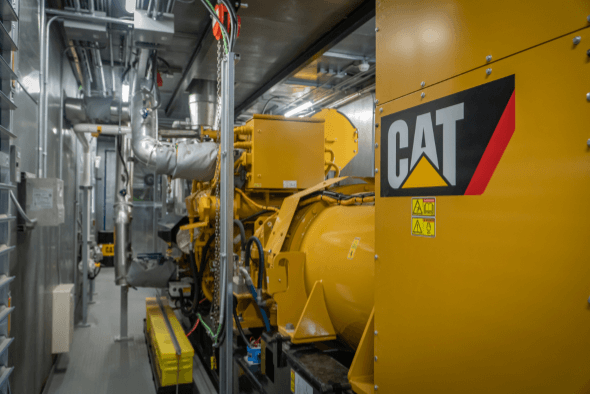When Edmonton International Airport (EIA) was looking at an energy-efficient option for electrical power generation, they decided on a combined heat and power (CHP) solution. This would not only provide them with the electricity they needed but capture the waste heat from the engines to heat EIA terminal.
The CHP application is perfect for an airport which operates 24/7 and it is also incredibly efficient. According to Chris Schurmans, Project Development Manager for Finning who worked with EIA on their customized power generation system, “Because we are capturing the heat from the generation of electricity and using that heat, we are gaining up to 45% generator efficiency and close to 40% thermal efficiency. Having a solution like this, offsets the need for water boiler use on site which reduces natural gas consumption while at the same time reduces reliance on Utility Power Generation such as coal power plants.
Not only is the CHP system at EIA incredibly efficient, this new natural gas cogeneration system reduces both emissions and costs.

Cogen utilizes both the electricity and the waste heat that is generated. It is designed to provide a baseload of power and heat, therefore, it doesn’t supply all of the heat and power required for EIA terminal building, but it does provide the baseload and is very economical from an energy and cost perspective. Roger Steele, Manager of Technical & Utilities for EIA is pleased with the results, “We’re getting the green benefits, we’re getting the redundancy and resiliency, and we’re also getting the utility savings. The net is almost $1M per year. That is really going to help with the payback of these units.”
The system at EIA is made up of three Cat® G3512H natural gas, high efficiency gensets. These engines generate 1.4MW at 4160V each. There are two transformers and two electricity transmission feeds for four sources of power generation, and switchgear to choose the power source. There are also three enclosures for the gensets that are locally designed and manufactured in Canada to withstand our harsh climate. Everything is custom tailored for our customer’s specific application, including the CHP heat recovery and emission reduction equipment, custom controls and switchgear, and site-specific sound attenuation.
“Designing a project like this is a collaborative effort with the customer,” says Chris. “We want to make sure the customer is getting what they are looking for and we understand that they require options when sourcing power generation solutions. And we’re able to provide those options with access to the extensive product range Caterpillar offers and the expertise Finning can provide in custom designing these solutions.”

Even though cogeneration is not a new idea, there are applications where it makes sense from a cost and energy-efficiency perspective. “The more we looked at it, the better the business case became. It is the perfect fit for our airport,” said Roger. “We are really hoping that this project is a springboard for others in Alberta to look at this technology for use in new or existing buildings.”
The plant is expected to cut the airport’s annual carbon emissions by roughly 20 per cent — or 7,000-8,000 tonnes of CO2 equivalent per year and reduce EIA’s energy costs by about $800,000 per year.
“Having this cogeneration facility that uses Alberta’s natural gas to produce power, and then use the waste heat generated to heat our terminal building is a win-win all around for us,” says Steve Maybee, VP Operations & Infrastructure with EIA.
Click here for more information on power generation solutions.
Share This